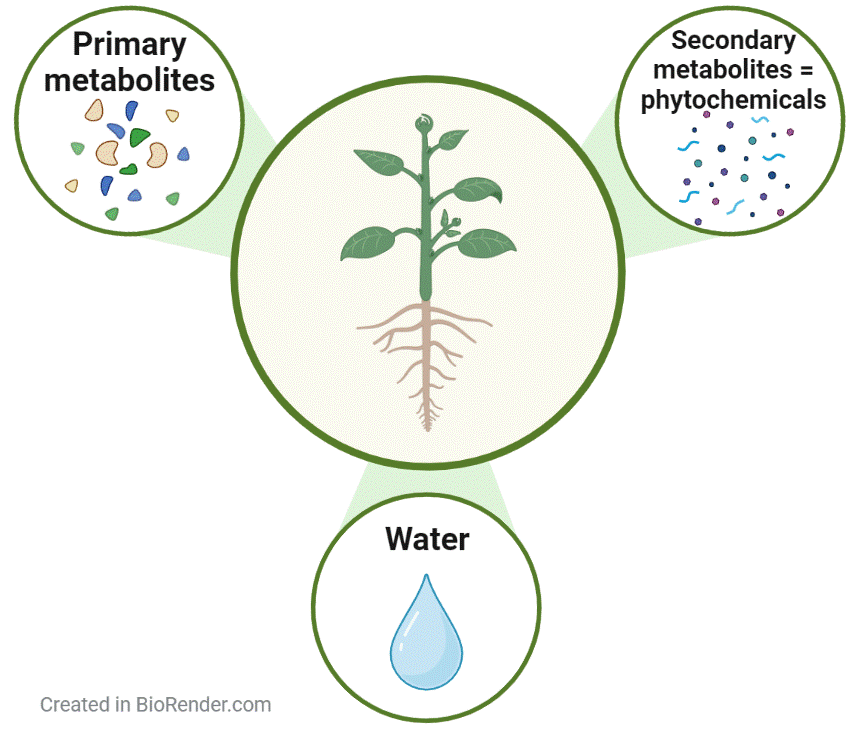A plant, what is this?

French version - Italian version - Spanish version
Since the dawn of time, plants have been an integral part of human life. Man first learned to recognize a poisonous plant from an edible one by its colour, smell, shape and the shape of its fruit, in order to feed himself. Over time, humans evolved and their knowledge changed: they became sedentary and learned to grow edible plants. They also discovered that plants could cure them. They passed on their knowledge orally until they learned to write. The first written records on the use of plants date back to the Mesopotamia (3,000 BC) with the Sumerian tablets: these are the beginning of pharmacy.
But ultimately, what is it that gives plants their therapeutic and nutritional virtues?
Plants are mainly composed of water: between 80 and 95% of their total mass, depending on species. Then, 2 main types of molecules are found: primary metabolites and secondary metabolites.

Primary metabolites
Primary metabolites are compounds that are essential for the development and growth of plants. They include carbohydrates, lipids and proteins.
Secondary metabolites
Secondary metabolites are also called phytochemicals. Several families are found in this large class, including polyphenols, nitrogen-containing compounds and terpenoids. They are non-essential for plant growth, but play a crucial role in the plant’s relationship with its environment, for example in the plant’s defence against predators or its protection against extreme weather conditions. Here are some examples:
- Polyphenols (hydroxycinnamic acids and some flavonoids) accumulate in the leaves and external parts of the plant and protect it from UV radiation.
- Anthocyanins are pigments that give the flowers their colour, attracting insects or birds and thus promoting pollination.
- Others molecules play a signalling role. For example, legumes use specific phytochemicals, called flavones, to attract soil bacteria of the genus Rhizobium, and through them acquire the ability to fix the atmospheric nitrogen necessary for their growth.
- Terpenoids in essential oils, thanks to their strong odor, have a repulsive role towards certain insects. We are well aware of the example of geranial and neral in lemongrass against mosquitoes.
- Finally, the bitter or pungent glucosinolates are said to play a defensive role against certain grazing animals.
In addition to these numerous benefits for plants, it has been demonstrated that secondary metabolites can also have effects in humans. Some compounds from plant foods, such as polyphenols, are thought to protect against various diseases, particularly cardiovascular and metabolic diseases. In contrast, other types of extremely potent phytochemicals are thought to be responsible for the toxicity of certain plants. A historical example is that of coniine, an alkaloid of poison hemlock (Conium maculatum), well-known for causing the death of Socrates.
It is therefore essential to know the great diversity of phytochemicals and their presence in different plants to better understand their effects in humans, whether beneficial or deleterious.
For more information:
- Egbuna C, Kumar S, Ifemeje JC, Kurhekar JV. Phytochemistry: Volume 2: Pharmacognosy, Nanomedicine, and Contemporary Issues. CRC Press; 2018. 621 p.
- Petrovska BB. Historical review of medicinal plants’ usage. Pharmacognosy Review. 2012;6(11):1‑5.
- Usages : eau dans plantes. Disponible sur: https://www.cnrs.fr/cw/dossiers/doseau/decouv/usages/eauPlant.html
- Bruneton J. Pharmacognosy, Phytochemistry, Medicinal Plants. 4e éd. Lavoisier; 2008. 1289 p.
- Miller R, Owens SJ, Rørslett B. Plants and colour: Flowers and pollination. Optics & Laser Technology. 1 mars 2011;43(2):282‑94.
- Majewska E, Kozlowska M, Gruszczynska-Sekowska E, Kowalska D, Tarnowska K. Lemongrass (Cymbopogon citratus) essential oil: extraction, composition, bioactivity and uses for food preservation - a review. Polish Journal of Food and Nutrition Sciences. 2019;69(4).
- Bachheti RK, Worku LA, Gonfa YH, Zebeaman M, Deepti U, Pandey DP, et al. Prevention and Treatment of Cardiovascular Diseases with Plant Phytochemicals: A Review. Evidence-Based Complementary and Alternative Medicine. 4 juill 2022:21.
